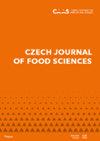蜂蜜的天然生物活性化合物及其抗菌活性
IF 1
4区 农林科学
Q4 FOOD SCIENCE & TECHNOLOGY
引用次数: 11
摘要
蜂蜜是一种复杂多变的混合物,含有来自不同分子家族的180多种生物化学化合物。这种混合物是在蜜蜂腹部处理植物食物来源的花蜜后获得的。在这种天然产品中发现的生物活性成分负责其抗菌性能。蜂蜜因其对革兰氏阳性(Gram+)和革兰氏阴性(Gram-)细菌的抗菌作用、对霉菌和酵母的抗真菌和抗真菌作用以及原生动物和抗病毒活性而被使用。这篇文献综述概述了蜂蜜的天然抗菌潜力;它解释了造成这种潜力的因素,并阐明了它们的作用机制。渗透压、水活性、蜂蜜的酸含量、生物活性化合物的存在,如过氧化氢(H2O2)、酚酸、类黄酮、甲基乙二醛(MGO)、防御素-1、溶菌酶、挥发性化合物以及这种抗菌活性背后的乳酸菌分泌的抗菌产物。这种潜力基本上取决于最初收获的花源的生物活性、地理来源、季节、储存条件、蜂蜜年龄、蜂群的健康状况和适当的养蜂做法。本文章由计算机程序翻译,如有差异,请以英文原文为准。
Natural bioactive compounds of honey and their antimicrobial activity
Honey is a complex and variable mixture that contains more than 180 biochemical compounds from various molecule families. This mixture is obtained after processing the nectar out of plant food sources at the level of the bee abdomen. The bioactive components found in this natural product are in charge of its antimicrobial properties. Honey is used for its antibacterial actions against Gram-positive (Gram+) and Gram-negative (Gram–) bacteria, its anti-fungal and antimycotic actions against moulds and yeasts, along with its protozoal and antiviral activities. This literature review outlines the natural antimicrobial potential of honey; it explains the factors responsible for this potential and spells out their mechanisms of action. Osmotic pressure, water activity, the acid content of honey, presence of bioactive compounds like hydrogen peroxide (H2O2), phenolic acids, flavonoids, methylglyoxal (MGO), defensin-1, lysozyme, volatile compounds as well as antibacterial products secreted from the lactic bacteria that are behind this antimicrobial activity. This potential basically depends on the biological activities of the initially harvested floral source, its geographical origin, season, storage conditions, honey age, health of bee colonies and suitable beekeeping practices.
求助全文
通过发布文献求助,成功后即可免费获取论文全文。
去求助
来源期刊

Czech Journal of Food Sciences
Food Science & Technology, Chemistry-食品科技
CiteScore
2.60
自引率
0.00%
发文量
48
审稿时长
7 months
期刊介绍:
Original research, critical review articles, and short communications dealing with food technology and processing (including food biochemistry, mikrobiology, analyse, engineering, nutrition and economy). Papers are published in English.
 求助内容:
求助内容: 应助结果提醒方式:
应助结果提醒方式:


